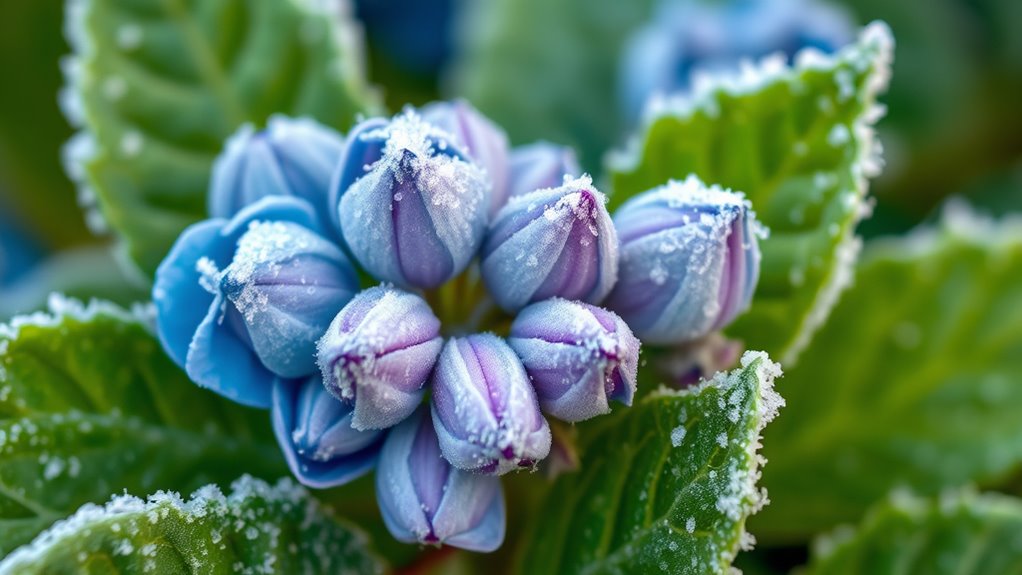Yes, hydrangeas can survive frost if you take proper precautions to protect their buds and blooms. You should guarantee the soil drains well, mulch around roots, and cover the plant with breathable materials on cold nights. Pruning early and watering deeply also help strengthen the plant against cold damage. By following these strategies, you’ll improve your hydrangeas’ frost resilience and enjoy vibrant blooms in spring. Exploring these tips further can help you keep your hydrangeas healthy year-round.
Key Takeaways
- Hydrangeas with well-draining, slightly acidic soil are more frost-resistant and better able to survive cold temperatures.
- Proper pruning in early spring helps remove weak stems, enhancing the plant’s resilience against frost damage.
- Covering buds and blooms with breathable materials like fleece protects them during cold nights.
- Mulching around the base insulates roots and stabilizes soil temperature, reducing frost risk.
- Watering deeply during the day and avoiding late-season heavy fertilization support winter hardiness.
Understanding Hydrangea Hardiness and Frost Tolerance

Understanding hydrangea hardiness and frost tolerance is essential for ensuring your plants survive and thrive through cold weather. One key factor is soil drainage; well-draining soil prevents water from pooling around roots, reducing the risk of freeze damage. Hydrangeas prefer slightly acidic, moist but well-drained soil, which helps them withstand lower temperatures. Pruning techniques also influence frost tolerance: avoid heavy pruning late in the season, as it can stimulate new growth vulnerable to frost. Instead, prune selectively in early spring, removing dead or weak stems. Proper pruning helps maintain plant strength and reduces frost-related damage. By managing soil drainage and employing appropriate pruning, you’ll improve your hydrangeas’ resilience to cold snaps and ensure healthier, more vibrant blooms.
Signs of Frost Damage on Hydrangeas

Frost damage on hydrangeas becomes visible when cold temperatures have affected the plant’s foliage and stems. You may notice browning or blackening of leaves, especially on less frost-resistant cultivars. Wilted or drooping blooms can also indicate frost injury. Stems might feel brittle or develop cracks if the frost was severe. If you planted frost-resistant cultivars, they’re more likely to show fewer signs of damage, but it’s still essential to assess the overall health of the plant. Cold weather pruning can help remove damaged branches and encourage healthy growth, but it’s best to wait until the danger of frost has passed. Recognizing these signs early allows you to take proper care and protect your hydrangeas from further harm. Additionally, understanding air quality can help in maintaining a healthy environment for your garden, especially in urban areas where pollution may impact plant health. Proper watering practices can also support recovery and resilience in stressed hydrangeas. Using an air purifier with HEPA filtration can help reduce airborne pollutants that may stress your plants, promoting overall health and vigor.
Effective Strategies for Protecting Buds and Blooms

To protect your hydrangea buds and blooms from frost, start by covering the plants with breathable materials like horticultural fleece or old blankets during cold nights. This creates a barrier against low temperatures while allowing moisture to escape. Additionally, adjust your watering techniques; water deeply during the day to ensure the soil retains warmth overnight, reducing frost risk. Proper fertilization schedules also help, as avoiding heavy fertilization late in the season encourages the plant to focus on developing sturdy buds instead of new growth that’s vulnerable to frost damage. Mulching around the base of the plant with organic material can insulate roots and maintain more consistent soil temperatures. Understanding the importance of contrast ratio in projectors can help you choose the right display setup for your home cinema, ensuring you enjoy vibrant visuals even during darker scenes. These strategies work together to minimize frost harm, protecting your hydrangeas’ buds and blooms effectively.
Best Practices for Winter Care and Maintenance

Proper winter care for hydrangeas guarantees they survive harsh conditions and blossom beautifully in the spring. To guarantee their resilience, focus on these best practices:
- Use pruning techniques wisely—remove dead or weak branches in late fall to promote healthy growth and prevent snow damage.
- Apply soil amendments like compost or organic matter to improve drainage and provide essential nutrients for winter hardiness.
- Mulch around the base with straw, wood chips, or leaves to insulate roots and maintain consistent soil temperature.
- Remember that understanding the specific hydrangea variety and its hardiness zone can help tailor winter protection strategies effectively.
Tips for Encouraging Healthy Hydrangea Growth in Spring

As temperatures rise and winter’s chill recedes, you should focus on supporting your hydrangeas’ growth to guarantee a lush, vibrant display. Establish a consistent watering schedule, ensuring the soil stays moist but not waterlogged. Proper watering encourages healthy root development and vibrant blooms. Additionally, use pruning techniques to promote new growth; remove dead or damaged stems early in spring, and shape the plant to improve air circulation. Aim to prune lightly, especially if you’re encouraging flowering for the season. Avoid heavy cuts that could hinder bloom production. Regular watering combined with strategic pruning helps your hydrangeas develop strong, healthy buds, setting the stage for a beautiful spring and summer display. Incorporating advanced fraud detection techniques can further safeguard your gardening investments from potential threats. For optimal results, consider using diverse designs of planters that enhance the aesthetic appeal of your garden while providing the necessary environment for healthy hydrangea growth.
Frequently Asked Questions
Which Hydrangea Varieties Are Most Resistant to Frost?
If you’re looking for frost-tolerant cultivars, consider hardy shrub varieties like Panicle hydrangeas and smooth hydrangeas. These types are more resistant to cold temperatures, making them suitable for colder climates. You’ll find that selecting these frost-tolerant cultivars helps your garden thrive through winter chills. Keep in mind, even hardy shrub varieties benefit from protective measures during extreme cold snaps to ensure healthy blooms come spring.
How Can I Identify Early Frost Damage on Hydrangeas?
They say a picture is worth a thousand words, and this rings true with frost damage indicators on hydrangeas. Early frost damage signs include wilting, browning or blackening leaves, and shriveled or discolored flower heads. You might notice hydrangea injury signs like soft, mushy stems or blackened buds. Catching these early helps you protect your plant and prevent further harm, so keep a close eye after cold nights.
Are There Specific Fertilizers That Improve Frost Resilience?
You might wonder if certain fertilizer types or soil amendments can boost your hydrangeas’ frost resilience. While fertilizers rich in potassium and phosphorus strengthen overall plant health, they don’t directly prevent frost damage. Using organic soil amendments like compost improves soil warmth and moisture retention, which can help protect buds during cold snaps. Focus on balanced fertilization and healthy soil to give your hydrangeas the best chance against frost.
When Is the Best Time to Prune Hydrangeas Before Winter?
You should prune hydrangeas in late summer or early fall, just before winter protection becomes necessary. Proper pruning timing helps remove dead or weak stems and encourages healthy growth, making your plant more resilient against frost. Avoid heavy pruning in spring, as this can expose buds to frost damage. By timing your pruning correctly, you guarantee the plant’s structure stays strong and its blooms are protected during winter.
Can Indoor Conditions Help Protect Hydrangea Buds From Frost?
Indoor conditions can definitely help safeguard hydrangea buds from frost. By practicing indoor gardening, you control temperature and humidity, creating a warm environment that minimizes frost damage. Using frost protection techniques like covering outdoor plants or moving potted hydrangeas indoors during cold snaps is also effective. These methods ensure your hydrangeas stay healthy and bloom beautifully, even when outdoor temperatures drop unexpectedly.
Conclusion
Knowing how to safeguard your hydrangeas from frost can make all the difference in your garden’s beauty. Did you know that hydrangeas can survive temperatures as low as 20°F with proper care? By understanding their hardiness and applying effective winter protection strategies, you’ll ensure healthy buds and vibrant blooms come spring. With a little effort now, you’ll enjoy lush, colorful hydrangeas season after season. Keep these tips in mind, and your garden will thrive year-round!









